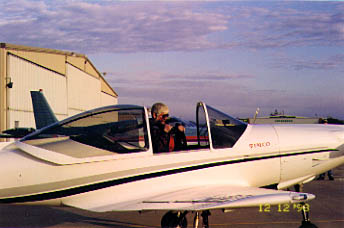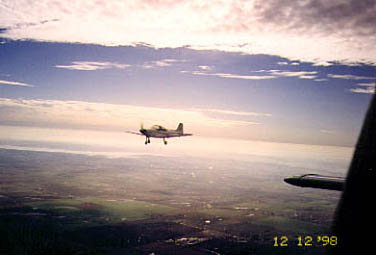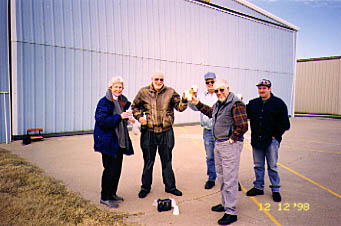![]()
A Flight Test of N98KM
![]()
|
|
A Flight Test of N98KM |
|
by Howard Benham
|
This article appeared in the December 1998 issue of Falco Builders Letter. |
The beginning of this test was really back in March of 1991. I received a call from Kim Mitchell introducing himself and asking if he could come to Wichita to look at our Falco. He and his wife Joyce showed up on the 29th of March, and they spent a couple of hours inspecting what Marty and I had completed and going over the blueprints. He told me that he thought he would buy the kit and start building as soon as his schedule would permit.
In June 1991, I spoke with him and invited him to our 4th of July fly-in at El Dorado, Kansas, to see Charles Gutzman's Falco. We both did the usual "Falco builders dance" of walk around, crawl under, and peer into to see how some of the construction steps had been accomplished.

Howare Benham straps in for the first flight.
After that I did not hear from Kim until August of 1998 when he called and asked if I would be willing to come to Ponca City, look over his creation and, if satisfied with the construction, do the initial flights after the FAA had signed off. I was surprised and somewhat hesitant as I had only done two other first flights, a Quickie in Iceland and my own Falco. Marty and I talked it over and decided to at least go down and look it over.
We flew the C180 down on the 5th of September. (Yes, I realize
that it is probably heresy to mention a store-bought in the FBL,
but it is a classic.) After one look at the beautiful job that
Kim had done I was hooked again! We agreed to come back after
the FAA did their thing at the end of September, do the initial
flights and also check Kim out in the new bird. He had been flying
a Piper Saratoga but was nervous about the Falco.
Then began a real circus of trying to fit my schedule at FlightSafety
with Kim's schedule and the weather. On the 1st of November, Marty
and I drove to Ponca City for four days to do a final inspection,
first flights and Kim's checkout. For those of you who follow
the national news, that was the same time that Mother Nature decided
that it was time for a 100-year flood in the Kansas/Oklahoma area,
so other than doing a very detailed inspection, Marty and I spent
our time touring the Marland Mansion and other wondrous sights
in beautiful downtown Ponca City.
We scheduled several other dates, but they were cancelled due to weather. But finally on the 13th of December everything finally came together. Marty and I took off from our strip before sunrise and by 9AM, we were ready to take off in the Falco. I wanted a couple of high-speed taxi runs just to get the feel of a real airplane again. After a year of flying in the middle east and the flight training that I do at FlightSafety, I was more than current but not in something as nimble as the Falco.
During the initial run-up there was an excessive mag drop. The GEM engine analyzer was showing the #2 and #4 cylinders with fouled plugs on the #2 mag. Everything else appeared normal so I elected to do a couple of the taxi runs at high power and lean mixture to see if the problem would clear. The control checks and handling were fine, however another check of the mags showed no improvement, so back to the hangar.
By the time I taxied back, Kim had already located two new plugs and was standing by with a couple of his helpers to change out the offending plugs. As soon as the engine cooled enough to pull the plugs, they were changed, and we were ready to go again. During all of this I wouldn't say that Kim was nervous, but I don't think that the stem on his pipe will ever be the same. Back to the runway and everything was okay.
Then I had to wait for Kim to fire up the Brand X to fly chase. I was afraid to wait any longer for fear of fouling the plugs again so as soon as they started to taxi, I started my takeoff run. It was cool, about 10°C, and the acceleration was terrific. Before I was really ready, the speed was through 65 kts, and I was airborne.
As I lifted off, there was a pronounced roll to the left which I quickly corrected with right stick and rudder. The climb was rapid, 1500 fpm at 90 kts and smooth. All engine parameters were in the green. As the speed increased, the force built up on the stick and at 110 kts I was having to hold three to four pounds of pressure to hold wings-level. Other than the left roll tendency, everything else was normal.
As with all the Falcos that I have flown, two-fingers-and-a-thumb is all that is needed for smooth control. Kim, Marty and Bill finally joined up, and we leveled off at 5000. Kim is not used to formation flying, so he stayed well to the side and below to see if I was trailing anything that I shouldn't be.
With the 'all clear' from Kim, I went through the usual first flight checks. The stalls were pretty much as advertised. A gentle buffet about 10 kts before the break during both the clean and flaps landing stalls at idle power. The left wing dropped sharply at the break but it recovered immediately when I released back pressure. Then it was time for a little more excitement which the first power-on stall produces. With full power applied, the pitch angle approached 25 degrees nose-up before the speed started to bleed off.
The buffet started at about 50 kts and at about 45 kts I got a look at the earth from an entirely new point of view. The break was sharply to the left, and the nose sliced quickly through the horizon to a 40-degree nose down 70-degree left bank. I set power to idle, released the back pressure and everything returned to straight and level. The first one happened so quickly that I didn't have time to check what effect the rudder might have on the break. On the first one I was concentrating on keeping the ball in the middle. So it was back to full power, nose up, wings level and wait for the break.
This time as I felt the break start I kicked in full right rudder and held full back pressure on the stick. The break was still to the left but not so sharply and with the addition of some right aileron the break to the left is stopped. After a few more combinations, it was time to quit having fun and return to the airport. The pattern is flown at 90 kts downwind, slowing to 80 on the base with 15 degrees flaps and 14" manifold pressure, flaps selected to down on the final and power adjusted to maintain 14" resulted in 70 over the numbers, power to idle in the flare with touchdown at about 60.

After the flight, our inspection showed everything was in good working order, and we planned another flight for the next day. However mother nature had other ideas and it was not until the 10th of January that we had a chance to do gear retraction and controllability checks. Kim has not installed any gear doors yet, and he says that will be a project for later. After join-up, we went through a series of retraction and extension cycles with out a hitch. After each extension, I checked the gear position with the manual extension handle but in each case the gear was fully extended. The only minor problem I noted was that the gear warning horn came on with the power set at about 20" manifold pressure which I feel is a little high. In order to get slowed down in the pattern, you have to either put up with the horn or shut it off and set yourself up for a possible gear-up landing if you get distracted.
Satisfied with the retraction, it was time to do what the Falco does best, go fast. With the gear up, I set up 24/24 and settled back to let speed stabilize. In short order I got a call from Kim wanting to know where I was as he couldn't keep up and had lost sight of me. The speed stabilized at 160 KIAS at 5000 ft pressure altitude. The OAT is 10°C. For those of you without your whiz wheels handy, that calculates out to a true airspeed of 169.3 knots, 194.9 mph, or Mach .26 for the jet jockeys.
This seemed a bit fast, but I didn't have time to do any more checking as I have gotten so far ahead of Kim that he probably thought I was stealing his new baby, so I did a quick 180 and flew back to look for the Brand X and join up on his right wing for some air-to-air shots. Marty was doing the photos, and she told Kim to have me wave, at which point he said he didn't want to distract me.
The Falco is a real dream to fly in formation. With its rapid response to the throttle, it is a breeze to join up on another plane without any overshoot. Marty got her photos and then it was back to the airport to get Kim in the left seat for his first flight in his new bird while I recorded flight data (FAA please note it takes two people to fly and record data). During the next two flights, Kim repeated the stalls and handling checks plus some speed checks against the GPS. With two on board, our airspeed was 152 KIAS at 5000' pressure altitude with an OAT of 17°C This figures out to 165.9 kts true.
We then did a series of two-way runs to cancel out the wind
and record an average ground speed of 162 kts. It will really
be interesting to see what this one will do when gear doors are
installed and the control rigging is adjusted to hands-off. All
in all it was a real pleasure to fly, and I am very grateful to
Kim for allowing me the honor and pleasure of flying this very
well-constructed and beautiful aircraft. It almost makes me want
to start building another Falco. Right now Marty and I are busy
restoring our 1957 Cessna 180, but once that is done who knows.
I just got off the phone with Kim and as of today he tells me
that he has about 10 hours now. He has installed a small wedge
on the bottom of the left aileron which has corrected the left
roll tendency. He really sounds like he is enjoying it so I guess
that means that my Falco flying days are over for a while.

Joyce Mitchell, Kim Mitchell, Bill Meadows, Howard Benham and
Lonnie Neel.
|
|